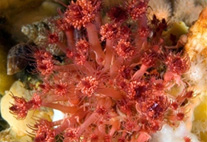Abstract
Zyzzyzus rubusidaeus, sp. nov., is described from inshore waters near the northern tip of Vancouver Island, British Co-lumbia, Canada. Specimens were collected on rocky bottoms amongst barnacles, sponges, and compound ascidians at a depth of 18 m in Weynton Passage, Broughton Strait, during March, July, and October 2012. Polyps tend to grow in dense aggregations, often covering several square centimetres. Hydroids of Z. rubusidaeus most closely resemble those of Z. robustus Petersen, 1990 from Greenland, but differ in having aboral tentacles that are scattered in a narrow band around the base of the hydranth rather than occurring in a single whorl, thin and transparent instead of thick and stiff perisarc around hydrocaulus and tubers, and gonophores that arise from simple pedicels instead of short, stout branches. Possible embryos were present in female gonophores, although structures recognizable as actinula larvae have not been observed. The cnidome comprises small and large stenoteles, desmonemes, microbasic euryteles, basitrichs, and isorhizas. Polyps are a raspberry colour in life, a hue that has faded but little in our formalin-preserved material. Discovery of this hydroid brings the number of species currently recognized in genus Zyzzyzus Stechow, 1921 to seven.

